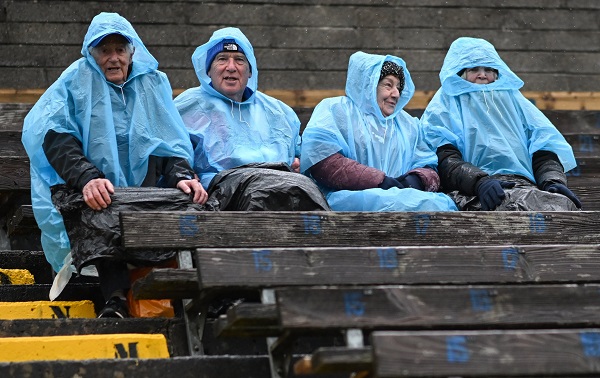WHEN Sétanta was crowned Cú Chulainn, surely even he himself didn’t know what he had let himself in for. His trusty camán and sliotar, enough to defeat the mighty hound of Culann. Let the magic begin, the self-proclaimed greatest game on Earth, and all the rest of it.
Lovely hurling.
They say he was born in Newgrange and grew up in Armagh, “neither a hurling stronghold”, to quote the great Mícheál Ó Muircheartaigh. In today’s world that would render him guilty of treason, for Sétanta clearly didn’t do enough to promote the game of hurling, whatever that even means.
If a soliloquy could change the world, then Donal Óg Cusack would be the CEO of Trócaire and the UN Secretary General all at once. If that day ever came to pass, even Cú Chulainn would turn back the hands of time and sacrifice himself to the dogs.
Unless of course the hound was more Gaelic football inclined. He wouldn’t have the wrists for hurling anyway.
Cusack in fairness has a right to be concerned. Arthur O’Dea hit the nail on the head with his the42.ie column: “Hurling is thriving, hurling is dying”. In the piece, he stated that each of Sligo, Mayo, Roscommon, Leitrim, Longford, Louth, Westmeath, as well as every Ulster team barring Antrim, have fewer hurling clubs than there are football clubs in Kilkenny.
Let that sink in…
In the wake of the GAAGo controversy of recent times, there is arguably a greater divide between football and hurling than ever. There is also a superiority complex, where the elite in either sport look down at the other from their high horse, all the while fearful of overstepping the line under this big, happy umbrella organisation that we call the GAA.
It’s no secret that the effect of that umbrella wears off if you have your head stuck in the clouds. Ian Brown seems to understand the belittling yet tentative hatred better than most.
“I am the resurrection and I am the light.
I couldn’t ever bring myself to hate you as I’d like”.
And so that brings us back to Donal Óg, a proud Corkman, as most of them are. Joanne Cantwell was within her right to question what the 46-year old had said the week previously. In fact, she gave him an opportunity, on national media, to either apologise or double down and stick to his guns. He did neither, and in the end was rescued by Anthony Daly and an awkward joke from Joe Canning.
It was still May of this year when rugby was the first victim of Cusack’s wrath, suggesting RTÉ and the GAA were “exploiting hurling”, and that “we’ve now given over 2023 to rugby country”. At the weekend just passed, two Munster Hurling Championship games took prime slots on RTÉ on Sunday, with huge clashes of Galway v Tyrone and Kerry v Mayo in the football playing perceived second fiddle.
The Tailteann Cup jibe was particularly strange given the imbalanced championships we have seen in recent years, as well as the jubilant scenes in Westmeath last year when they became inaugural winners. What’s more is the fact that the hurling championship has long since been tiered.
His RTÉ co-panellists have been accused before of just smiling and nodding, but the three men in the studio on Sunday are not just hurling men, they also share a tainted perception of the issues that exist as a result of coming from a dual county. Cork, Clare, and Galway are in a bubble to an extent. Perhaps that is why the relentless calls of “promote the game” have little to no substance behind them.
It only takes one day at Cúl Camps in the back arse of County Monaghan to see the full extent of the problem.
“I hate hurling.”
“We did hurling yesterday”.
“”When are we playing football again?”.
The coaches try their best, but they too have little heed, having been exposed to the same environment, just for a longer period of time. Loosening and tightening the Mycro helmets on a variety of different sized heads can be as much of a problem for them as it is for the playing personnel. It is difficult to ever imagine a day where the lack of enthusiasm wanes.
In recent years, Castleblayney have dominated the club scene, coinciding with their footballers’ first ever relegation to the intermediate ranks. Their success has been almost artificially implanted with hurling DNA, with coaches from Antrim, Carlow, Kilkenny, Wexford and more.
When Castleblayney achieved perhaps the greatest ever hurling feat in Monaghan, in making the 2019 All-Ireland Junior Club final, Malachy Clerkin painted a picture that exists only in the deep reaches of Daly, Canning, and Cusack’s imagination, but this is reality.
Kilkenny versus Monaghan in Croke Park. Less of a fixture, and more of an April Fools’ Day headline. Clerkin writes:
“Talk about two worlds colliding. ‘Blayney are one of only five hurling teams in Monaghan, one of which is an amalgamation of disparate hobo hurlers from the north of the county. Figures published by the GAA during the week pitch the number of adult hurling teams in Kilkenny at 88. In ‘Blayney, hurling is a lifestyle choice, the sort of oddball pursuit that might mark a fella out as an attention-seeker. In Dunnamaggin, hurling is life.”
Receive quality journalism wherever you are, on any device. Keep up to date from the comfort of your own home with a digital subscription.
Any time | Any place | Anywhere












